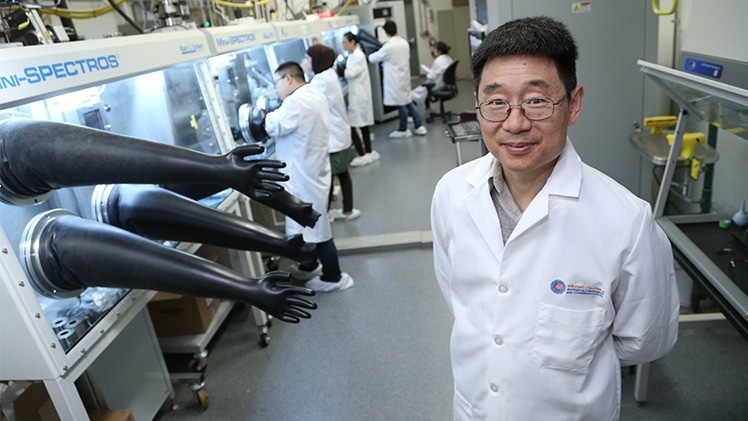US physicists overcame a significant barrier to commercializing solar cells made with halide perovskites as a less expensive, more efficient alternative to silicon when harnessing solar energy.
 Clean energy research led by Dr. Yanfa Yan, UToledo Distinguished University Professor of physics and a member of the UToledo Wright Center for Photovoltaics Innovation and Commercialization, clears the path for the commercialization of new photovoltaic technology to replace silicon and lower the cost of solar electricity. Image Credit: University of Toledo
Clean energy research led by Dr. Yanfa Yan, UToledo Distinguished University Professor of physics and a member of the UToledo Wright Center for Photovoltaics Innovation and Commercialization, clears the path for the commercialization of new photovoltaic technology to replace silicon and lower the cost of solar electricity. Image Credit: University of Toledo
The durability issue with perovskite solar cells was resolved in clean energy research led by The University of Toledo in collaboration with the Universities of Washington, Toronto, Northwestern, and Swiss Federal Laboratories for Materials Science and Technology.
This research, which was published in the journal Science, brought the technology one step closer to being used to power solar panels on the consumer market.
Perovskite solar cells offer a route to lowering the cost of solar electricity given their high-power conversion efficiencies and low manufacturing cost. However, we needed to strengthen the emerging solar cell technology’s endurance during outdoor operation.
Dr. Yanfa Yan, Distinguished University Professor, Physics, University of Toledo
Dr. Yan is also a member of the University of Toledo’s Wright Center for Photovoltaics Innovation and Commercialization.
The technology must be able to survive for decades outdoors in all types of weather and temperatures without corroding or degrading.
Yan added, “This challenge is no longer a roadblock to deploying the potential of perovskite solar cells. Our breakthrough work improved device stability and presents ways of achieving success after a decade of research and development.”
The group identified the component that improves adhesion and mechanical toughness.
Researchers conducted an experiment to show that perovskite solar cells treated with 1,3-bis(diphenylphosphino)propane (DPPP), a diphosphine Lewis base molecule, kept a high-power conversion efficiency and displayed superior durability even after being used continuously for more than 3,500 hours, or more than 145 days, under illumination similar to that of the sun.
They made use of what is referred to as one sun illumination, which is the same as natural sunlight.
Yan continued, “Phosphine-containing Lewis base molecules with two electron-donating atoms have a strong binding with the perovskite surface. We saw the robust beneficial effects on perovskite film quality and device performance when we treated the perovskite solar cells with DPPP.”
Dr. Zhaoning Song, one of the authors of the study and a research assistant professor in Yan’s lab at the university, stated, “DPPP is also a commercialized product with low cost and easy accessibility, which make it suitable for the commercialization of perovskite solar cells.”
The next step in advancing the technology, according to researchers, is to use their discoveries to stabilize perovskite panels.
Yan collaborated with Dr. Chongwen Li, the study’s first author and a graduate of UToledo. In 2020, Li graduated with a Ph.D. in physics from UToledo. He works as a postdoc at the University of Toronto.
Continuing to exploit the potentiality in the stability of perovskite solar cells is a crucial priority for the ongoing decarbonization of the world’s economy. After the successful demonstration of DPPP on improving the stability of perovskite solar cells, we are further applying it to large area perovskite solar panels and moving the prototype device forward to commercialization.
Dr. Chongwen Li, Study First Author and Postdoctoral Researcher, University of Toronto
For more than 30 years, the University of Toledo has led the way in solar energy research and development.
Since Yan’s team at the University of Toledo discovered the ideal characteristics of perovskites, compound materials with a unique crystal structure created through chemistry, they have been concentrating their efforts on combining two different solar cells to increase the overall electrical power produced by utilizing two different parts of the sun’s spectrum.
A group of researchers from the Universities of Toledo, Toronto, and Northwestern University worked together in November to produce an all-perovskite tandem solar cell with a record-breaking voltage. The study was published in Nature.
Journal References:
Li, C., et al. (2023) Rational design of Lewis base molecules for stable and efficient inverted perovskite solar cells. Science. doi:10.1126/science.ade3970
Chen, H., et al. (2022) Regulating surface potential maximizes voltage in all-perovskite tandems. Nature. doi:10.1038/s41586-022-05541-z